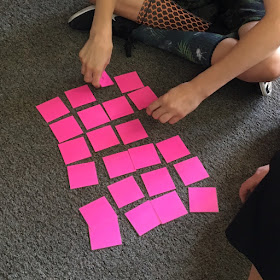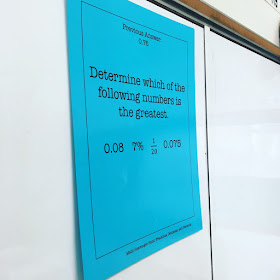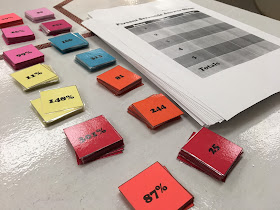The last couple of weeks have been all about fractions, decimals, and percents in sixth grade math! Over the last few years, I have continued to add and alter activities to help my students grasp these concepts. For my 6th graders, this unit includes a lot of conversions and comparing of the three types of numbers, as well as a lot of practice finding the percent of a number. Following, are a few of the activities that I have found helpful for my students. I'd love to hear about other ways that you get kids motivated to learn these concepts in the comments below!
As we begin learning about converting decimals to fractions, it is so important for students to have a solid understanding of place value. They must be able to accurately read decimals (0.8 is "eight tenths" not "zero point eight!") in order to understand how to write these decimals as fractions. These foldable notes are one method that I use to help students remember their place values and how to properly say these numbers. I have found these foldable notes to be valuable activities for my 6th graders. They somehow seem so much more motivated to take notes on the folded paper as opposed to in their notebooks!
After we have learned how to convert between decimals, fractions, and percents, I use several resources and activities to help them practice these conversions. I have found that my students become very good at each type of conversion (ex: fractions to decimals) when we spend all day doing only that conversion. It is so much harder for them to remember how to do each conversion when we put it all together at the end of the unit! We make these foldable notes to help them remember and practice the different conversions. I love watching them refer to these notes as they work on problems in class.
Another resource that I have found helpful to practice these skills is this Fractions, Decimals, and Percents Memory game. Students take turns flipping over two cards as they try to find the matching numbers (ex: 1/8 and 12.5%). This has been a fun way for them to practice!
The second review activity I have the sixth graders do is this Fractions, Decimals, and Percents Scavenger Hunt. I don't know what it is about scavenger hunts, but they are weirdly motivating for students! I use these for a lot of other topics as well. If you haven't tried them out, I highly recommend them. Students start at different problems that are posted around the room. After solving their problem, they must find that answer at the top of one of the other problems. Eventually, the should make it around to each problem, ending up at the problem in which they started!
Once we have mastered these conversions, we move on to finding the percent of a number. This is such a valuable, real-world, skill that students will use! My free Percent Scramble game is a fun way for students to practice finding the percent of a number. It takes some printing, cutting, and laminating ahead of time, but is definitely worth it as you watch the students have fun solving these problems!
Finally, I am always looking to challenge my students who pick up on the concepts right away. The last thing I want is for students to be bored in class (we all know what behaviors that can lead to!). Here is one of the Challenge of the Week problems I always post during this unit. All of my sixth grade Challenge of the Week problems are free in my TpT store.
Hopefully you were able to find something useful when it comes to learning about fractions, decimals, and percents in middle school math! As a stated earlier, I'd love to hear what you do to help your students understand these concepts in the comments below!







No comments:
Post a Comment